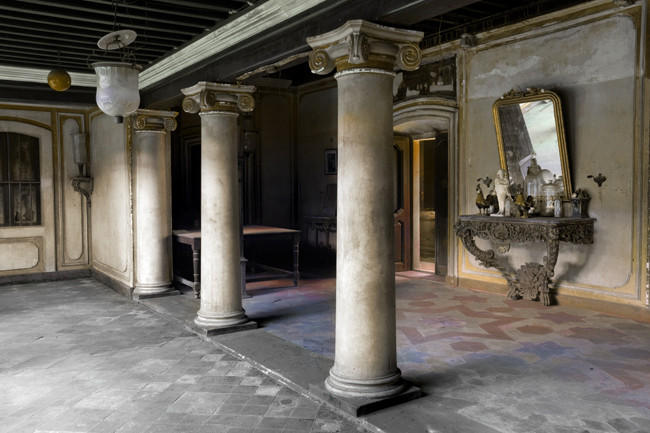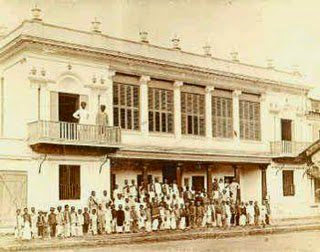At A Carnatic Concert, Pondicherry
Awe-inspiring memorial concert for Mandolin Srinivas
An 11 minute read
- blog
- India
- carnatic
- mandolin
- thavil
- hindu devotional
- improvisation
- classical
- Mandolin U Rajesh
- Mandolin Srinivas
- AK Pazhanivel
- Pondicherry
- rhythm
- performance
- art
U Rajesh - a background interview and playing demonstration
Just back from my first Carnatic concert.
L’Ecole Societe Progressiste is a once-grand building, crumbling like so much else in Pondicherry, the one-time bastion of French India. Inside is a large square corridor that wraps around a square courtyard. Now a school, it was doubtless built as a traditional Tamil-style merchant’s house, where the central courtyard provided a place for ritual, breathing, communal living. We are in the internal part of Pondicherry, ‘la Ville Noire’, where all the houses once followed this design: rooms around a central courtyard, supported by a phalanx of rounded hardwood pillars with intricate curlicues at the top.

House with ornate pillars, Pondicherry. See Sebastian Cortes’s lush photo book for more
In the courtyard itself, while the crowd of curious intellectuals gather on white plastic chairs, they shift from once spot to another to get an unobstructed view of the stage past the rounded pillars. These are the same hardwood pillars that you see lining the East Coast Rd, propped up against antique shop-fronts alongside gnarled, but beautifully carved wooden doors and windows. There are so many exquisitely shaped pillars and doors on display, stacked up in great, mouldy piles, that you can imagine Pondicherry’s grandeur in its full glory. A town where these carved pillars, strong like the trees they were cut from, held up every grand veranda.
 Societe Progressiste High School, Pondicherry
Societe Progressiste High School, Pondicherry
Children’s drawings hang from the ceiling, blowing to the rhythm of the electric fans. The courtyard roof has been long been closed to make the building work better in its present function as a school. Most space on the walls is taken: mostly garish educational printed posters with number, letters and vegetables in Tamil and English, and old photographs of gods, saints and patrons. Everything in the room it seems, was once white: now everything has been coloured by time and humidity, etching the same old stains of brown, ochre, mottled grey on every surface.
The stage, set in front of the only wall that does not hide a door, and therefore a classroom, is simple, space enough for five people to sit on, crossed legged in the performance style.
The musicians arrive without a fuss a few minutes before the concert is due to begin dressed in white shirts and kurtas. They sit on stage and prepare without fanfare, taking out instruments, an engineer brings a microphone.
An announcement is made by a beaming, bespectacled Chairman in Tamil, presenting the concert and the musicians, to much applause. It is the one year anniversary of the death of Mandolin Srinivas, the artist who made the mandolin a possibility in Carnatic music. As a special guest, joining U Rajesh, Mandolin Srinivas’s equally illustrious mandolin-playing brother (do keep up), is AK Pazhanivel, maestro of the the Tamil folk drum, the thavil. The audience respond with applause, and the musicians, hand on their heart to acknowledge the announcement, continue to tune up.
Thavil god AK Pazhanivel at his day job
It is not so common to see a thavil player in Carnatic music, which has a resolutely traditional core, and tolerates rather than encourages fusions with other musics. This, perhaps, is different for two reasons: firstly, as a thavil player, AK Pazhanivel is strictly from a devotional tradition, usually performing in Hindu temples, at festivals and life rituals. Carnatic is a strictly devotional art form that is loved equally in the metropolis. Its two biggest music festivals, each lasting a month, reflect this: one is in the relatively glitzy surroundings of the Madras Music Academy in Chennai, and the other at a temple complex in the holy city of Thiruvaiyaru, Tamil Nadu’s answer to Varanasi, where pilgrims flock to bathe in the Ganges. The founding composer of Carnatic music, Tyagaraja, is now a saint, with his own temple here, and it is here that music lovers from across the South come for a more intense, devotional musical experience.
As befitting the occasion of a memorial for his illustrious brother, the opening hour has U Rajesh and his mandolin as the focus. Progressing through a series of ragas (that I am not yet enlightened enough to know), mostly in a straight 4/2/2 beat called ata thalam (one bar of four beats, then two bars in two beats each), I am left literally open-mouthed.
Let us start with the quality of the playing: U Rajesh is literally the finest instrumentalist I have seen live. Carnatic musicians at the very top of their game combine many qualities that I, for one, have never seen together in single concert. I’ll try to list them out here, in an effort to understand fully what I have witnessed.
Beauty
Even to the relatively untrained ear, it is hard not to appreciate the beauty of the melodic phrases, often long and langorous, particularly in the introduction, or alaap. With time, I suspect it becomes all the more beautiful.
Ragas for the armchair music fan
Skill and sensitivity
The emotional moods of the ragas - each one demands a particular sequence of notes, which can be different depending on the direction of a musical phrase - requires great dexterity. The Carnatic music audience is famously knowledgeable, and therefore ready to pounce on a musician who plays a single note out of raga. This is not jazz, where you can play in or out. In Carnatic, to play out will lead to you being thrown out.
Speed and technique
The man shreds like Hendrix - I kid you not. Enough said.
Narrative
The emotional arc over the period of the three hour concert unravels slowly, with great satisfaction. Like the top dance music DJs, the performers guide the audience through the emotions above with great feel, knowing exactly how long to dwell on one emotion or texture before going to the next.
The second mandolin shadows the lead perfectly
Improvisation
As any great artist will tell you, parameters are what makes great art. Form is defined by its limits, and the great artist is defined by how he or she navigates through and around them. In its rhythmic, modal and textual limits, Carnatic is a highly sophisticated, complex form. Which makes the ease with which improvisation is carried out by a master truly a joy to behold.
Collective energy
The relationship between the musicians onstage is a delight to watch, constantly communicating, smiling, encouraging and feeding off each other.
Humility
The prodigies onstage display not a single ounce of ego. Throughout the concert, the audience respond with sighs at a phrase well played, or brief applause for an improvisation. At the end of three hours of exhilarating art, they merely raise their hands in ‘Namaste’, and start to pack their instruments.
Jugalbandi: AK Pazhanivel with Zakir Hussain
Rhythmic Excitement
Rhythms are pulled apart, sliced and diced, multiplied, cross-threaded and woven back into complex polyrhythms, all while the musicians - and the entire audience - keep track of the basic thalam, or beat cycle, tapped out on their knees. It is an exhilarating game to watch the three percussionists dart in and out of the basic rhythm, challenging each other to follow, if they dare. One hour of the concert is dedicated to the jugalbandi: the duet between two musicians who take turns to challenge one another. AK Pazhanivel is outstanding here, leaving the other musicians gasping with delight.
Precision
This is a precise form: articulation matters. All of the above is delivered with intent. It is never a free for all: carnatic music always has poise and elegance.
Lack of pretension
There is something about the simplicity of the surroundings, the sheer unpretentiousness of the environment that makes its greatness all the more impressive.
Precision, grace and devotion, breathtaking technical ability, deep communication on stage, exquisite melodies, satisfying narrative arc over the whole concert: these are just some of the qualities that make a Carnatic concert, lasting three hours, fly by.
What more perfect school of music is there? Where else is there an art form as balanced as this? Where a musician can weep sorrow one moment and shred like Hendrix the next?
I could dedicate the next decade of my life to understanding this art. The concert was that good.